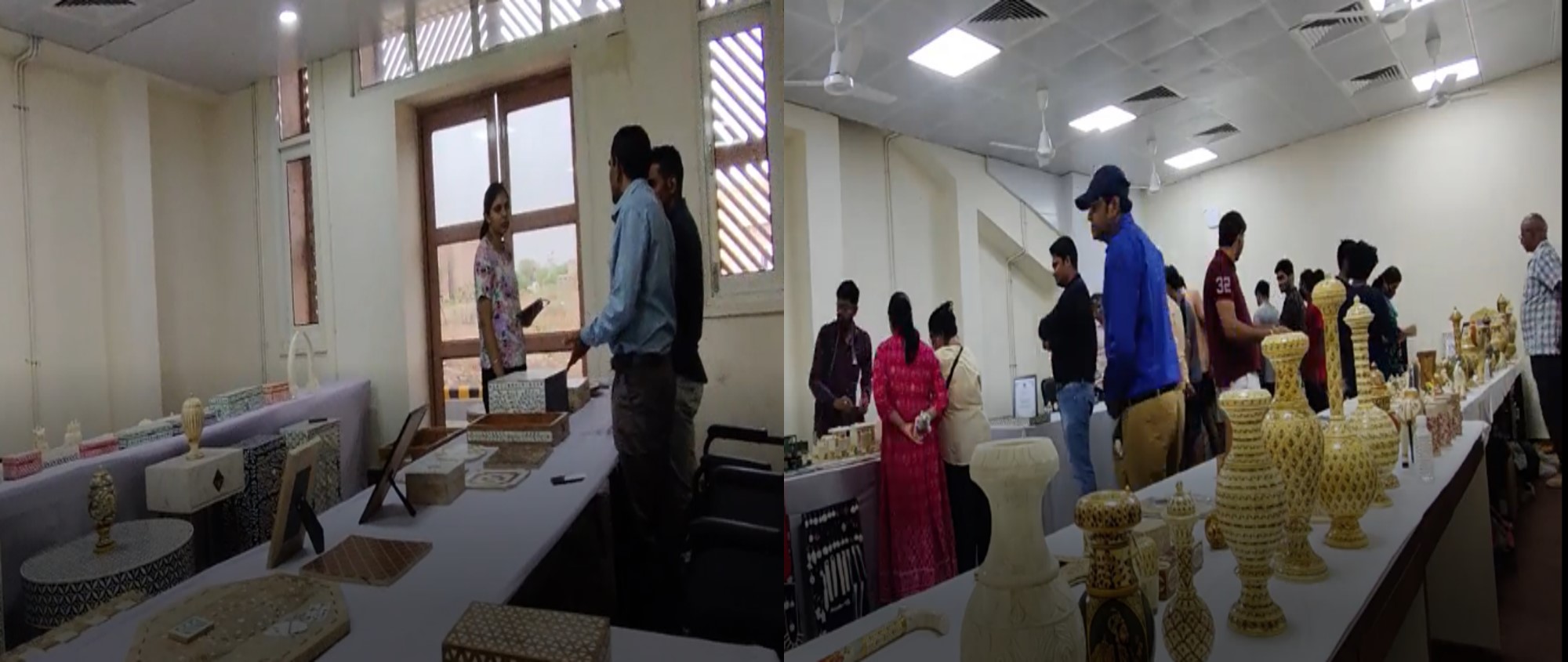
- A+
- A
- A-

A variety of bone and horn handicrafts
Image credit: Jodhpur City Knowledge and Innovation Foundation
On 2nd and 3rd July 2022, a hall at the Indian Institute of Technology (IIT) Jodhpur brimmed with a myriad of products made of bone and horn; one could find everything from a model of the Taj Mahal to coffee tables, models of trains and buses, handbags, jewellery, and a variety of decorative items, all intricately carved and painted, some purely from bone and some made of bone embedded in wood. This was a two-day open house exhibition cum sale organised by the Jodhpur City Knowledge and Innovation Foundation (JCKIF), jointly with IIT Jodhpur.
The event, inaugurated by Prof. Sampat Raj Vadera, Deputy Director of IIT Jodhpur, displayed products by seven local handicrafts manufacturers and had robust footfall. Other dignitaries who were present included Prof. Abhimanyu Kumar, Vice Chancellor of Rajasthan Ayurved University; Mrs. Seema Kavia, RAS Registrar at Rajasthan Ayurved University; and Mr. Abhishek Surana IAS, CEO, Zila Parishad.

Some of the 700 visitors at the event speaking to the sellers about their work
Image credit: Jodhpur City Knowledge and Innovation Foundation
Speaking of the motivation for conducting this event, Dr. G. S. Toteja, CEO, JCKIF, who was a key member of the organising committee, said, “Our goal is to help these artists in the unorganised sector promote their work, not just here in Jodhpur but worldwide, so that their work is appreciated, they see good sales, and this industry progresses.”
To help these artisans with global marketing, JCKIF is creating a digital museum of their products. This is a crucial initiative, catalysed partly by lessons learned from the economic hit the handicrafts industry took during the first two years of the COVID-19 pandemic: when the manufacturers’ brick and mortar establishments were forced to close down, their poor digital literacy, difficulty in understanding English, and the complex paperwork on e-commerce portals prevented them from keeping up sales online. This, in addition to the fact that the 200+ marketing events and fairs that the government helps organise for them every year did not occur, created a major revenue shortfall for the industry.
Exhibitions such as this one and initiatives for digitisation—including upskilling in digital technologies—will prove to be key steps for reviving these artisans’ livelihoods. And when it comes to the latter, JCKIF becomes a major player as the Jodhpur Science and Technology Cluster, operating under the aegis of the PSA Office.
Dr. Toteja explains, “One of JCKIF’s key responsibilities as a science and technology cluster, is to facilitate collaborations among local institutes to first identify knowledge and technology gaps in the handicrafts sector, and then design and implement digital technologies for value addition in this sector. Our goal is to preserve the richness of this traditional heritage and art in Jodhpur, so that future generations see it thriving. To date, we have held several workshops to assess the needs of artisans working in block printing, tie and dye, leather mojhari, and bone and horn crafts. And now, here, at IIT Jodhpur, we are enabling these bone and horn artisans, equipping them for the future through digitisation.”
A testament to the success of the event are the words of one of the participants: “This exhibition is doing us a lot of good. It is helping us get value for our work, especially as it takes a lot of time to create something.” The event not only boosted sales and awareness about the handicraft, but also increased respect and admiration for the artisans.

Dr. G S Toteja, CEO of JCKIF with artists at the exhibition
Image credit: Jodhpur City Knowledge and Innovation Foundation
Bone and horn crafts are, indeed, a big part of Rajasthan’s handicraft industry and its culture. The goal should be to not only preserve the art and revive artisans’ livelihoods, but also ensure sustainability in these aspects. Moreover, this is an environmentally sustainable craft form—with only dead animals’ bones being used—and would do well with a boost not just in Rajasthan but across the nation, in states such as Uttar Pradesh, Odisha, Bengal, Karnataka, and Kerala where, too, this is a traditional handicraft form. Perhaps, this exhibition and digitisation initiative at IIT Jodhpur is a step in these directions.
Rachana Bhattacharjee is an author, creative lead, and one of countless chroniclers of the information age.




